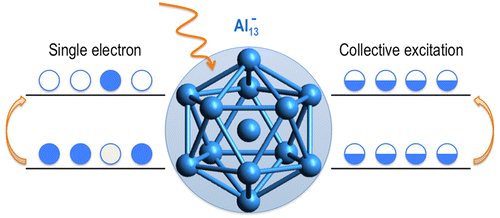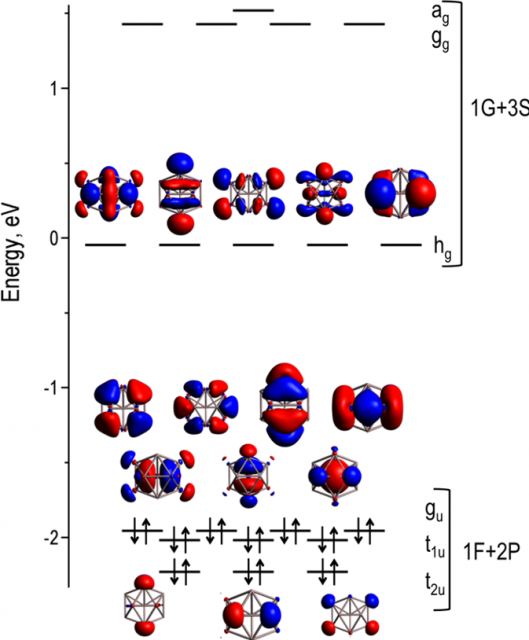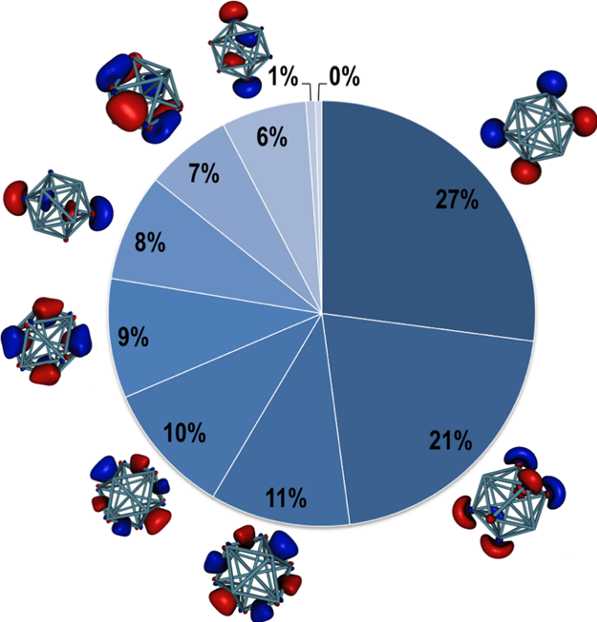Plasmonic resonances in an aluminium magic cluster

Al13− is one of the most attractive of the so-called magic clusters. It has a perfect icosahedral symmetry with an aluminum atom at the center, a closed-shell electronic configuration (40 electrons), and a large highest occupied molecular orbital−lowest unoccupied molecular orbital (HOMO− LUMO) gap. These features result in an unusual stability and chemical inertness, similar to noble gases, that make the clusters inert toward coalescence.
But up to now the optical properties of magic clusters have remained largely unexplored. Still, these family of compounds are good candidates for the study of plasmonic-like resonances in small nanoclusters.
Plasmonics refers to the study of the optical properties of materials and their potential applications in biosensing, imaging, photovoltaics, in cancer therapeutics, or in the design and fabrication of metamaterials. The plasmon resonance is defined classically as a collective electronic excitation characterized as oscillations of the electronic density caused by restoring forces created by the induced electromagnetic field.
The presence of plasmonic states is a common feature in some extended systems. Plasmons have been postulated to arise also in finite systems, from nanostructures to molecular compounds. In particular, this phenomenon has been theoretically and experimentally studied for a large variety of systems such as in sodium clusters, metallic nanoparticles, in polycyclic aromatic hydrocarbons, or in graphene. These discoveries open new opportunities in the field, which may have strong implications in the development of new and improved applications.
In this context, aluminium nanocompounds have gained much attention in the last years due to their enhanced plasmonic properties. Experimental and theoretical works have shown that aluminium nanocompounds such as nanoparticles, nanorods, or nanodisks exhibit plasmon resonances from the visible to the deep UV regions. Nanostructures as small as 20 nm across were investigated and the importance of the oxide shell was also analyzed. Because of the size of the nanocompounds, theoretical macroscopic models were used. But, to use ab initio methods, smaller structures need to be considered.
Simultaneously, the interest for highly stable (pseudo)-spherical clusters has been revived in the past decade. In particular, clusters that have closed-shell valence electron configuration according to the jellium model have been found to be particularly stable, receiving the generic name of “magic clusters”. In particular, the Al13− anion and some of its dopped derivates have shown very promising.
Now a team of researchers from DIPC and Kimika Facultatea (UPV/EHU), led by David Casanova, an Ikerbasque researcher, has explored and characterized1 collective excitations in the Al13− anionic cluster and their plasmonic nature.

They used two different approaches to identify and characterize the collectivity of electronic transitions. They create a collectivity index as a measure of the number of electron/hole pairs participating in the excitation, scaling of the electron−electron interactions. The researchers then applied these ideas to the study of simple models and to perform a deep analysis of the electronic excited states of Al13− .
The researchers extend the use of the inverse participation ratio (IPR), a mathematical tool that, in the frame of quantum mechanics, is employed to characterize the nature of electronic states, to the analysis of electronic transitions, thus, creating the new index, TIPR. The IPR value is typically used as an indicator of how many states a particle is distributed over, and it is obtained by applying a simple mathematical expression to the set of electron occupancies of the natural orbitals. TIPR builds on this by using the transition occupation numbers, providing a quantitative index of the collective nature of the electronic excitations.

The team found that the icosahedral symmetry of the cluster induces a large density of states obtained as electronic excitations from the highest occupied to the lowest unoccupied energy levels. In their analysis, they identified the existence of low-lying electronic states with strong collective character in Al13−, which might be labeled as plasmon-like transitions.
This work shows that combining TIPR values with computed oscillator strengths can be used to identify optical plasmons in nanostructures. It opens the opportunity for the study and applicability of this type of electronic transition in aluminum clusters and in other related nanostructures.
Author: César Tomé López is a science writer and the editor of Mapping Ignorance
References
- David Casanova, Jon M. Matxain, and Jesus M. Ugalde (2016) Plasmonic Resonances in the Al13− Cluster: Quantification and Origin of Exciton Collectivity J. Phys. Chem C doi: 10.1021/acs.jpcc.6b03210 ↩